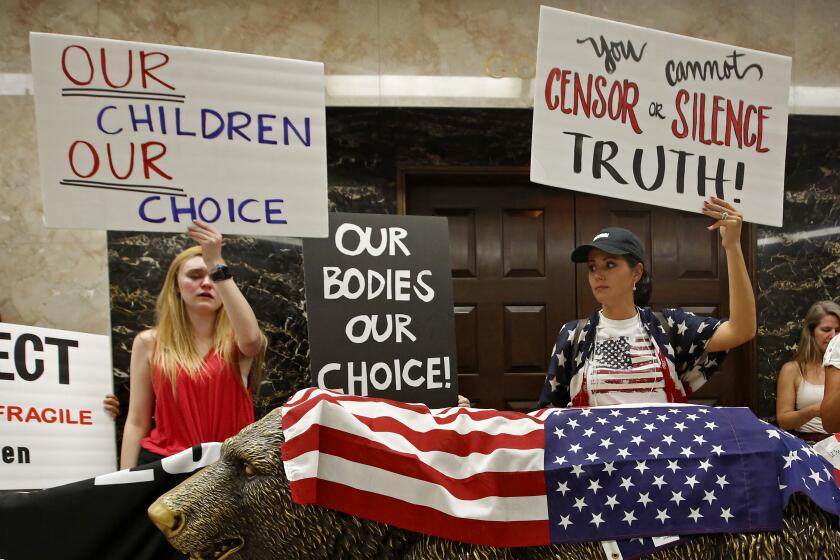The science of hunger strikes
- Share via
ROYAL OAK, Mich. — Hunger will change you. Just ask Thomas Mahany.
The Michigan stonemason and veterans’ advocate has starved himself three times in the name of justice, living only on water spiked with lemon juice and salt for weeks at a time.
Mahany knows how hard your body struggles, how you eventually get used to the gnawing in your stomach, but grow so weary over time that breathing itself becomes a chore.
He knows too that food deprivation affects more than just the body.
“When there’s no food in your stomach, you get your energy from the emotions of others,” the 66-year-old Vietnam veteran said. “You get extra sensitive to what people are thinking. If they are against you, you get away from them. If they are negative, they will drain you.”
As about 100 prisoners at the U.S. military’s Guantanamo Bay detention center refuse food, Mahany’s journeys through self-imposed famine provide a close-up look at why someone would choose to starve himself — and what happens when he does.
An energetic man who complains that most people suffer from “a serious case of the ‘slows,’” Mahany has a compact, solid build and wears a graying goatee and glasses. He looks more like a typical baby boomer on the cusp of retirement than a serial hunger striker.
But there’s an intensity lurking below the surface that’s hard not to miss, and he’s easily stirred by memories of the past, of episodes of cruelty and prejudice that he’s witnessed, either in the military or in the civilian world.
“We’re all born innocent, and it’s only later that we develop these discriminations, jealousies and alienations,” he said. “But deep down, everyone still has that innocence in them. That’s what the hunger strike is. It’s the most nonviolent, innocent form of protest there is.”
His first fast in 1970, to protest the U.S. incursion into Cambodia during the Vietnam War, was staged outside the White House and lasted 29 days.
“I’ve never got to the point where my life was in danger, but a buddy of mine did,” Mahany said.
Nutrition expert Dr. Caroline Apovian said that by the 40th day without sustenance, the body’s fat reserves have been exhausted, and the body has begun to feed upon itself. Muscle-tissue proteins are broken down into their constituent amino acids and rearranged to support bodily functions, said Apovian, director of the Nutrition and Weight Management Center at Boston Medical Center.
The strength with which the heart pumps blood begins to fade, and the body’s ability to adapt starts to break down. The hunger striker begins to lose sight and hearing. Speech becomes slurred and the skin grows dry and scaly, eyes twitch in their sockets and limbs lack coordination. The hunger striker suffers vomiting and difficulty swallowing. There may be internal bleeding.
Irish Republican Army hunger striker Bobby Sands lasted 66 days before his death in prison sparked riots in Northern Ireland. Just days before he entered a coma and died, Sands seemed to hear echoes in his head, journalist David Beresford wrote. “His mouth was twisted as if he suffered a stroke. He had no feelings in his legs and could only whisper.”
At Guantanamo Bay, 30 of the hunger strikers are being kept alive via forced tube feedings. Several determined prisoners have been trying to starve themselves since 2005 and remain chronically malnourished and physically frail, according to camp medical officials.
In many ways, such extended hunger strikes are a testament to the body’s ability to adapt to famine and scarcity — conditions that our early ancestors had to endure with lethal regularity.
In fat times, food is consumed and broken down into the simple sugar called glucose, which serves as the life-sustaining fuel for those trillions of cells that constitute the human body. Some of this fuel is stored in the muscles and liver, but only enough to last several days.
With such limited fuel reserves, the body acts quickly to conserve energy. After just eight hours of fasting, the body begins to slow its metabolism — the rate at which it consumes energy. The heart pumps blood more slowly, and the body produces less heat, sending a chill through the hunger striker. The gut sends out a hormonal alert that food procurement is a top priority, and hunger pangs build.
Mahany recalled this sensation during his first hunger strike. He opposed the war in Vietnam and wanted to take action. He hoped that by showing his commitment by fasting, he could meet with the president and urge him to end the war.
“During the first three days, I was really, really hungry and I was getting weaker and weaker,” Mahany said.
He was also troubled by the fact that the lead protester had begun his hunger strike 10 days earlier, but didn’t seem nearly as tired. Worried that he was “doing something wrong,” Mahany went to sleep one night and was shocked by what happened next.
“I woke up on the sixth day with lots of energy,” Mahany said.
Like a hybrid car switching from gas to electric power, Mahany’s body had begun burning fat stores instead of glucose. In some cases, this switch may be accompanied a cessation in hunger pains, as well as a sudden sense of well-being, and even euphoria, researchers say.
Scientists theorize that this lifting of spirits is an evolutionary response. Faced with the prospect of starvation, early man needed a hormonal kick in the pants to put food on the table.
“If you need to find food, you can’t be having hunger pangs and wallowing in your misfortune,” Apovian said. “You need to get out there and be creative.”
But as his strike continued, Mahany started feeling drowsiness, muscle pain and dizziness, and lost weight at a rate of one pound a day. He began to appear gaunt, while his breath became labored. “If I had to climb a flight of stairs, I’d need to stop in the middle to take a break,” he said.
At the same time as the body is breaking down, more changes are occurring to the hunger striker’s brain chemistry, scientists say. A number of studies suggest that prolonged fasting gives rise to increased irritability, anger, aggressiveness and impulsive behavior.
Daniel Fessler, an evolutionary anthropologist at UCLA, theorizes that these changes are an adaptive mechanism triggered by a drop in the neurotransmitter serotonin. This drop, which appears to accompany extreme losses in body weight in humans and other mammals, may have helped boost aggressiveness and risk-taking behavior in our ancestors so that they could out-compete others for food.
Fessler points to a seminal study on starvation that was conducted near the end of World War II. The University of Minnesota experiment was intended to help the government respond to widespread starvation in Europe following the war and involved three dozen volunteers who were conscientious objectors.
For six months, the young men were fed just 1,500 calories a day and lost 25% of their body weight.
“The changes were striking,” Fessler said. “These are pacifists who did not want to go to war and they start having violent fantasies and become self-injurious. One guy, after repeated failed attempts, finally manages to chop off a couple of his fingers.”
Mahany said he wasn’t prone to lashing out at people during his hunger strikes, saying, “I was too tired to get angry.”
Mahany said his first experience with restricted food intake occurred at the U.S. Military Academy in West Point, N.Y. As a cadet who often clashed with upper classmen, he was frequently deprived of dinner as a result. As his list of demerits grew, Mahany said he resigned from the academy after his third year, became a private first class in the 101st Airborne Division and was sent to Vietnam.
“I’d always ask myself, where does this anger come from?” girlfriend Lorelei Heinmiller said. “The more I learned about his past, the more I understood.”
In his first hunger strike, Mahany and his fellow protester were given an audience with President Nixon’s national security advisor, Henry Kissinger. In the second case, in 2009, Mahany ended his protest when government officials allowed him to participate in discussions about the military’s stop-loss program, which prevented active-duty personnel from leaving the military once their contracts expired. Mahany and others called the practice a “backdoor draft.”
Mahany fasted for 17 days last year to bring attention to the problem of suicide in the U.S. military and to urge the government to do more to address post-traumatic stress disorder.
By this time, the park across from the White House had changed a lot. “There was a real fringe element there that, frankly, I didn’t want to associate with,” Mahany said. The demonstration ended when the president signed an executive order concerning military and veterans mental health. (Mahany continues his advocacy on the issue as president of Honor for All.)
Asked whether he has any lasting physical problems from his serial hunger strikes, Mahany shrugged his shoulders. “I don’t know — you tell me,” he said.
By all appearances, periodic fasting has done little to impede Mahany’s productivity. He spent several recent days trucking a couple tons of granite stone from the Adirondacks in New York to a client’s home in a tony Detroit suburb; organizing an August golf benefit for Honor for All; and talking to a reporter as he sawed, chiseled and cemented stones into a low garden wall.
At one point, Mahany took a moment to assess the wall, which needed to be finished before the client threw a graduation party the following week. Another contractor who was working on the site walked over and attempted to strike up a conversation.
“Hoo, boy. I’m feeling a little woozy,” the contractor told Mahany. “I didn’t have any lunch today.”
“Oh, yeah?” Mahany said with a grin. “You on a hunger strike?”







